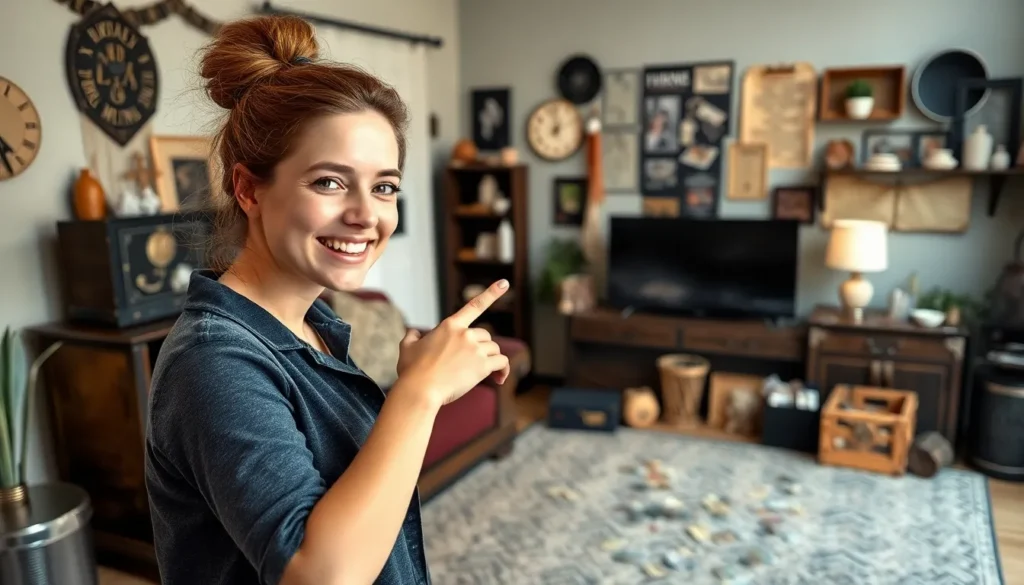Imagine transforming your living room into a thrilling escape room where the stakes are high and the fun is even higher. With a DIY escape room, you can unleash your inner game master and create a unique adventure right at home. No need for fancy equipment or a degree in puzzle design; all it takes is a sprinkle of creativity and a dash of imagination.
Table of Contents
TogglePlanning Your DIY Escape Room
Planning a DIY escape room involves creativity and strategic thinking. Consider the following elements to create an engaging experience.
Choosing a Theme
Selecting a captivating theme sets the tone for the experience. Popular options include detective mysteries, historical adventures, and science fiction scenarios. Each theme offers unique narrative possibilities and clues that align with the intended story. A clear theme helps participants immerse themselves in the experience. For instance, a pirate treasure hunt can use nautical clues, while a spy mission might feature hidden codes and gadgets. Encourage guests to dress according to the theme, enhancing the overall atmosphere.
Setting Difficulty Levels
Determining the right difficulty level ensures guests find the experience enjoyable without feeling overwhelmed. Consider the age and experience of participants when designing puzzles. For beginners, use straightforward clues and solve them quickly. An intermediate level might include more challenging puzzles requiring teamwork and critical thinking. For advanced players, incorporate complex riddles and multi-step challenges. Balance the difficulty levels to maintain engagement throughout the game. Each level can include a time limit to increase the excitement and urgency.
Designing the Room
Designing an engaging DIY escape room involves careful planning and creativity. Consider how the space can enhance the overall experience.
Layout and Space Considerations
Space plays a crucial role in creating an escape room atmosphere. Choose a room with adequate size for movement and activities. Divide the layout into distinct sections to accommodate different puzzles or challenges. Create pathways that guide participants from one task to another, maintaining a natural flow. Allow enough room for players to gather without feeling cramped. If a room lacks physical space, consider using curtains or furniture to divide areas temporarily.
Props and Decorations
Props and decorations add depth and immersion to the escape room experience. Select items that align with the chosen theme, like vintage books for a library puzzle or treasure maps for a pirate quest. Arrange these elements strategically to catch players’ attention. Use common household items creatively, such as converting boxes into treasure chests or repurposing old furniture as clues. A cohesive decor style enhances the overall ambiance and makes the challenges feel more authentic. Prioritize quality over quantity, ensuring that each prop serves a purpose that fits seamlessly into the narrative.
Creating Puzzles and Challenges
Designing engaging puzzles enhances the excitement of a DIY escape room. Creativity plays a crucial role in crafting challenges that captivate participants.
Types of Puzzles
Diverse types of puzzles keep the game stimulating. Consider incorporating word puzzles, such as crosswords or anagrams, to challenge participants’ vocabulary. Logic puzzles can stimulate critical thinking, while riddles encourage creative problem-solving. Physical challenges, like finding hidden objects or assembling pieces, add a hands-on element. Group challenges promote teamwork, allowing participants to collaborate on solving clues. Thus, using a mix of these puzzle types ensures a dynamic experience that caters to varying skill levels.
Scripting the Experience
Scripting the experience allows for a structured narrative. Define the story arc from start to finish, detailing key moments and plot twists. Each puzzle should connect seamlessly to the overarching theme, enhancing immersion. Creating character roles can elevate participant engagement, allowing players to embody their personas. Transitioning between puzzles with hints or narrative clues keeps the momentum flowing. Prioritize pacing to maintain excitement, ensuring participants never feel stuck or disengaged. A well-crafted script enhances the overall adventure and ensures a memorable experience.
Setting Up the Game
Creating a refined atmosphere is vital for an engaging DIY escape room. Prioritize timing and rules to enhance the game experience.
Timing and Rules
Establishing a time limit adds excitement to the challenges. A typical timeframe ranges from 45 to 90 minutes, allowing enough time for teamwork and puzzle-solving. Next, clarify the rules to set expectations for participants. Players should understand the categories of puzzles they’ll encounter and what’s permitted in their search for clues. Example rules might include no using phones or breaking props. Clear communication of the guidelines ensures everyone remains focused and engaged throughout.
Testing the Escape Room
Testing the escape room serves as a crucial step before hosting guests. Invite a small group to experience the game, allowing for fresh perspectives on puzzles and flow. Collect feedback about puzzle difficulty and enjoyment levels. Adjust any elements based on this input to enhance participant experience. Ensure that timing aligns with the intended challenge level, modifying puzzles if necessary. Conducting this test run helps identify any potential issues, ensuring a seamless and enjoyable event for everyone involved.
Conclusion
Creating a DIY escape room at home offers a unique opportunity for fun and bonding. By harnessing creativity and imagination participants can craft unforgettable experiences that rival commercial escape rooms. Thoughtful planning around themes puzzles and props enhances immersion and engagement ensuring everyone enjoys the adventure.
Testing the setup beforehand allows for fine-tuning and ensures a smooth experience. With the right mix of challenges and a captivating narrative players will find themselves fully absorbed in the journey. This home-based escape room can be a fantastic way to bring friends and family together for a memorable and exciting challenge.














